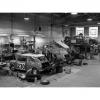Hello TMF,
I am hoping someone can help me out with an electronic dizzy problem I have found myself with. I recently bought a car with a 1275 motor, the engine does start and run but it is giving me a few problems which I am hoping someone can help me with.
I believe that the problem I have is that the timing on the dizzy is out, and I am ideally looking for some help as to how to correct this. I will detail my problem below and hopefully someone will be able to help me out.
The engine starts relatively well I would say and idles quite well, how ever as soon as you give the motor a bit of throttle it goes very lumpy, erratic and unresponsive, if you continue to give it the faintest bit of throttle the engine backfires through the carb which is how I have come to the conclusion that the problem is due to timing (sparking with the inlet valve still open?).
If this was a mechanical dizzy then I would start by twisting the dizzy cap until this problem stopped but I have no experience with Electronic Dizzys and am reluctant to touch anything just yet in case I do more damage than good.
Could anyone give me any advice as to where I should start, What the problem could be and how I could get rid of it? I could be completely off the mark with my diagnosis of the fault so any sort of pointers would be fantastic.
Thanks in advance for any help, Tomm




















